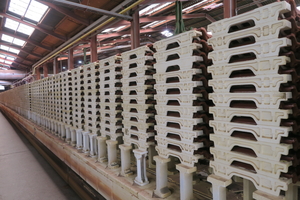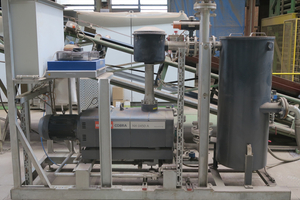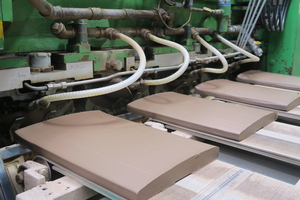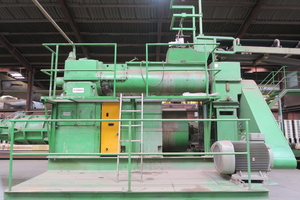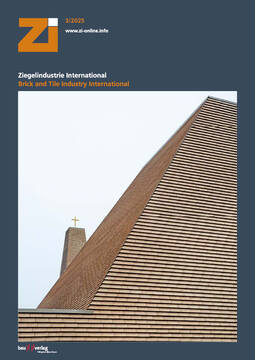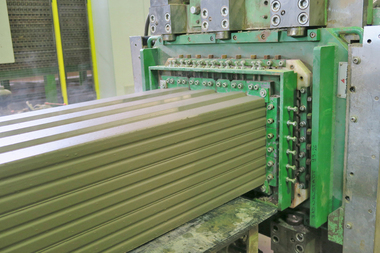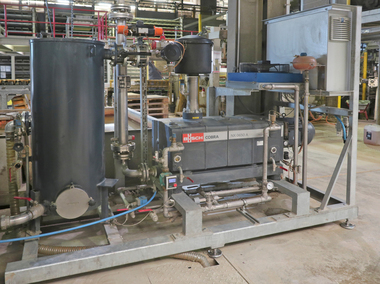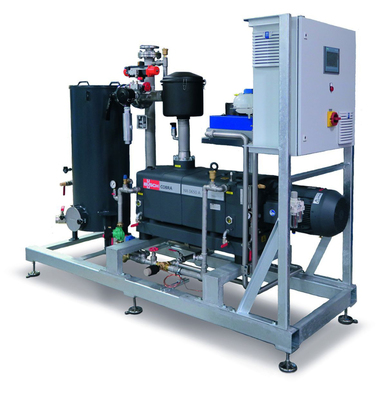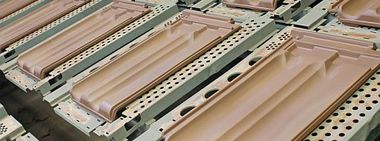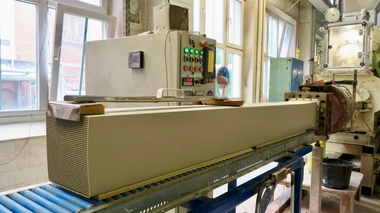Halving electricity consumption thanks to vacuum
Energy savings of up to 50 per cent and effortless maintenance: the KDW clinker roof tile factory has been benefiting from this since it started using a COBRA screw vacuum pump from Busch Vacuum Solutions for clay degassing.
The clay is piled high in the entrance hall of the KDW clinker roof tile factory in Natrup-Hagen near Osnabrück, Germany. A conveyor belt transports the material to a circular screen feeder, a powerful, cylindrical machine that optimally mixes, moistens and homogenises the various clays until the perfect starting material for the high-quality KDW roof tiles is ready. In the further course of production, the clay mass prepared in this way is compacted using a vacuum so that the finished tiles later have a particularly homogeneous appearance. This process is carried out by a clay degassing system from Busch Vacuum Solutions, the centrepiece of which is a COBRA NX dry screw vacuum pump from Busch Vacuum Solutions.
KDW is the smallest roof tile factory in Germany. In a single-shift operation, the workforce works around nine hours on weekdays and half a shift on Saturdays, producing between 125,000 and 130,000 tiles per week. KDW obtains its clay, which is mostly shale clay, from several pits in the surrounding area. The plant was founded in 1990 and has 25 employees. It is part of the ABC-Klinker Group, an owner-managed manufacturer of high-quality roof, facade, facing and floor ceramics with a total of 250 employees at six production sites, which can look back on around 135 years of experience.
Low energy consumption and effortless maintenance
After KDW operations manager Ingo Hofmeister had inspected the dry screw vacuum technology from Busch at another brickworks and was convinced of its advantages, he decided to test a COBRA NX for clay degassing. Initially, it was only to serve as a backup for the liquid ring vacuum pump that KDW had previously used for this purpose. But after just a short test phase, the operations manager was so impressed with the COBRA that he decided to use it permanently: “I quickly realised that it made sense not to keep the COBRA as a backup pump for emergencies because it is absolutely low-maintenance and we don‘t have to top up with operating fluids,“ enthuses Ingo Hofmeister “It also consumes much less energy. That‘s why it now does the work in clay degassing. We are still keeping the liquid ring vacuum pump as a spare. However, it has not been used at all so far.“
The COBRA NX degasses the clay and dehydrates the plaster moulds: First, it sucks trapped air bubbles and gases out of the material as it passes through the vacuum chamber between the twin-shaft mixer and the extrusion press. If the air and gas inclusions were not removed from the clay, they could lead to cracks during firing or shorten the service life of the bricks. The clay strands are then cut into individual clay blanks on the so-called cutter and fed via four parallel conveyor belts to a turret press, where they are pressed into their final shape between two plaster moulds. There, the COBRA NX extracts the water that is pressed out of the material during the pressing process through the moulds so that no water stains or marks appear on the bricks. This avoids unnecessary waste during the production process and increases productivity. The clay degassing and dewatering of the plaster moulds also guarantees the homogeneous appearance and high, frost-resistant quality of the KDW roof tiles.
Energy-efficient degassing with VSD
The COBRA NX, which Hofmeister uses in the clay degassing system, is equipped with a Variable Speed Drive (VSD). It adjusts the motor speed and ensures that a constant vacuum level is maintained. If the vacuum requirement drops during the production process, this results in a reduced speed and therefore lower energy consumption. This can be the case, for example, if the clay is less moist and therefore less moisture needs to be extracted from the vacuum chamber with the air. Thanks to the highly efficient COBRA with speed-controlled drive, KDW benefits from considerable energy savings compared to the uncontrolled liquid ring vacuum pumps, which were constantly running at full power. This is because energy savings of up to 50 % can be achieved by adjusting the speed to the actual demand. “The liquid ring vacuum pumps were always running at full power. The COBRA, on the other hand, regulates itself without any problems, even in damp, dirty environments,“ explains Ingo Hofmeister.
In fact, degassing moist masses is no problem for the COBRA NX. It has an anti-corrosion coating, which gives it a particularly long service life even in damp and dirty environments. At KDW, the specialists at Busch also installed a stationary filter upstream of the COBRA for the separation of dust and particles. This saves space, is easy to clean and also protects the pump from damage caused by contamination. A control cabinet, an intake filter and a cooling water circulation unit complete the COBRA clay degassing system.
Good spare parts supply
For the operations manager at KDW, it is particularly important to be able to produce smoothly. He is therefore pleased with the fast service provided by the vacuum specialists from Busch: “So far, we haven‘t needed any spare parts for the COBRA. But it‘s good to know that they would be available immediately in an emergency. With the liquid ring vacuum pumps, we sometimes had to wait weeks for spare parts.“ Service centres and regional service technicians enable Busch to provide its customers with spare and wear parts quickly and reliably when required. The operations manager is also very satisfied with the minimal maintenance required for the COBRA: “We only have to service the COBRA once a year. Otherwise, we occasionally replace the filter. But even changing the filter is completely uncomplicated. The pump alerts us as soon as it is necessary.“
Ingo Hofmeister is certain that he has opted for the optimum technical solution with the COBRA NX: “Because things are going so well with the Busch pump, we are even considering replacing all our liquid ring vacuum pumps with COBRAs,“ he explains with satisfaction.

